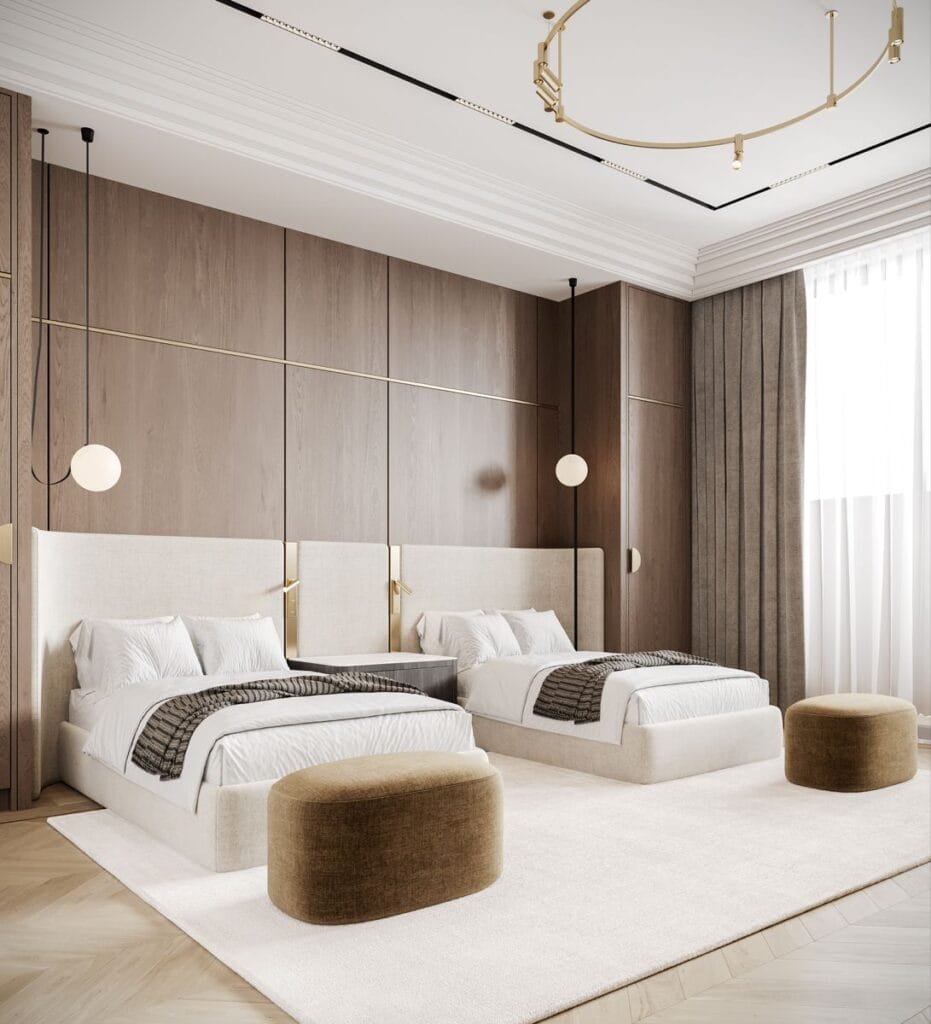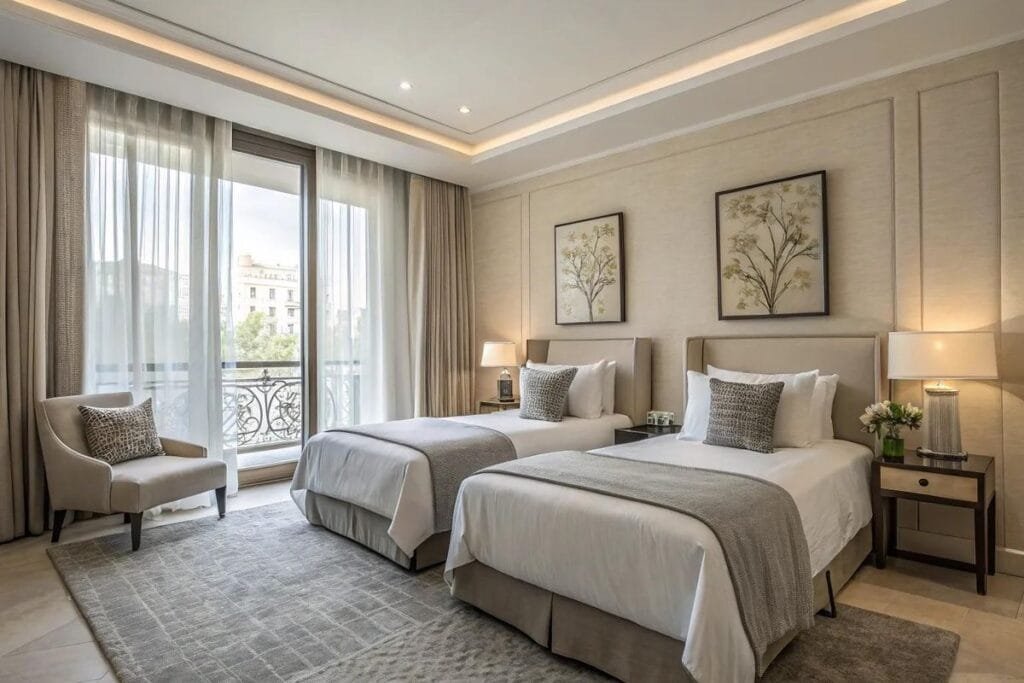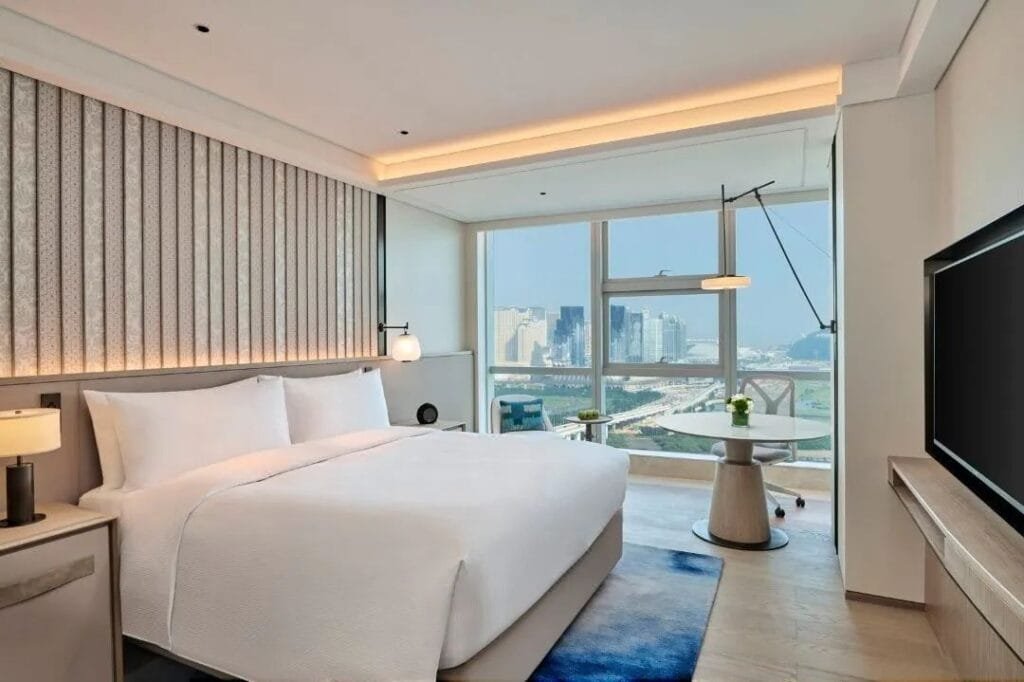
Have you ever booked a “double bed hotel room” online, only to arrive and find something completely different from what you expected? You’re not alone in this confusion.
The hospitality industry’s room classification system often creates misunderstandings between hotels and guests, particularly when it comes to double bed hotel rooms. Many travelers assume that booking a double room guarantees a specific bed size or configuration, but the reality is far more complex.
Understanding the nuances of hotel room types and bed configurations can dramatically improve your travel experience while helping you avoid costly booking mistakes. The terminology varies significantly across different countries, hotel chains, and property types, making it essential for modern travelers to decode these industry-specific terms.
This comprehensive guide explores everything you need to know about double bed hotel rooms, from understanding regional variations in terminology to making informed booking decisions that ensure your comfort and satisfaction. You’ll discover how hotels categorize their accommodations, what to expect from different room types, and practical strategies for securing the exact sleeping arrangements you need for your stay.
Whether you’re a frequent business traveler, vacation planner, or hospitality professional, mastering these concepts will transform how you approach hotel reservations and guest experiences.
Understanding Double Bed Hotel Room Terminology and Classifications
The term “double bed hotel room” represents one of the most misunderstood concepts in the hospitality industry, creating confusion that spans continents and cultures. Unlike standardized measurements in other industries, hotel room classifications have evolved organically across different regions, leading to significant variations in what constitutes a double bed room.
Hotel room classification systems typically focus on occupancy capacity rather than specific bed dimensions, which creates the primary source of confusion for travelers. A double bed hotel room fundamentally refers to accommodations designed for two guests, but the actual bed configuration can vary dramatically depending on the property’s standards, location, and target market.
In North American hotels, a double bed hotel room most commonly features one full-size bed measuring 54 inches wide by 75 inches long. This configuration provides approximately 27 inches of sleeping width per person when shared by two adults, which many sleep experts consider insufficient for comfortable rest. However, the compact footprint allows hotels to maximize room count within their available floor space while keeping rates competitive.
European interpretations of double bed hotel rooms often differ significantly from North American standards. Many European properties feature two single beds pushed together to create a larger sleeping surface, a configuration known as “twin-together” or “continental double.” This arrangement typically provides 70-76 inches of combined width, offering more space than traditional North American double beds while maintaining flexibility for solo travelers who prefer separate sleeping surfaces.
Asian markets present even greater variation in double bed hotel room configurations. Properties in countries like Japan often feature smaller bed dimensions due to cultural preferences and space constraints in urban environments. Conversely, luxury resort destinations in Southeast Asia may offer oversized double accommodations that exceed Western standards.

The Double Bed Hotel Room Configuration Comparison table below illustrates regional variations:
| Region | Common Bed Configuration | Typical Dimensions | Occupancy Comfort | Price Range |
|---|---|---|---|---|
| North America | Single full/double bed | 54″ × 75″ (137cm × 191cm) | Moderate for couples | $80-$200/night |
| Western Europe | Twin beds pushed together | 35″ + 35″ × 79″ (180cm × 200cm) | Good for couples | €70-€180/night |
| United Kingdom | Standard double bed | 54″ × 75″ (135cm × 190cm) | Moderate for couples | £60-£150/night |
| Asia-Pacific | Varies by property class | 47-59″ × 75-79″ | Variable | $50-$300/night |
Boutique and independent hotels often create their own interpretations of double bed hotel rooms, sometimes featuring custom bed sizes or unique configurations that don’t conform to chain hotel standards. These properties may offer zip-and-link beds that can be configured as either two singles or one larger double, providing flexibility for different guest preferences.
Business hotels typically standardize their double bed hotel room offerings to ensure consistency across multiple properties. Major chains like Hampton Inn, Holiday Inn, and Courtyard by Marriott have established specific bed size requirements for rooms classified as doubles, though these standards may vary between domestic and international locations.
Luxury hotel interpretations of double bed rooms often exceed basic industry standards, featuring premium mattresses, enhanced bed linens, and sometimes oversized dimensions that blur the line between double and queen classifications. Properties like Four Seasons, Ritz-Carlton, and St. Regis may use “double” terminology while actually providing queen-sized accommodations.
Extended-stay properties face unique challenges in double bed hotel room design, as guests may occupy these spaces for weeks or months. These hotels often prioritize durability and comfort over space efficiency, leading to different bed selection criteria than traditional hospitality properties.
The seasonal availability of double bed hotel rooms varies significantly based on property type and location. Beach resorts may favor larger bed configurations during peak seasons when couples predominate, while business hotels maintain consistent double room inventory year-round to accommodate solo travelers and colleagues sharing accommodations.
Understanding these fundamental variations in double bed hotel room terminology provides the foundation for making informed booking decisions and setting appropriate expectations for your accommodation experience.
Regional Standards and Cultural Differences in Hotel Bed Configurations
Cultural sleeping preferences significantly influence how different regions approach double bed hotel room design and configuration. These preferences, developed over centuries of cultural evolution, directly impact guest satisfaction and hotel design strategies across various international markets.
European hotel standards reflect the continent’s diverse cultural landscape, with significant variations between Northern, Southern, and Eastern European approaches to double bed hotel rooms. Scandinavian countries often favor firmer sleeping surfaces and cooler room temperatures, leading hotels to select different mattress types and bed configurations compared to Mediterranean properties.
In Germany and Austria, double bed hotel rooms frequently feature two single beds with separate mattresses and bedding, reflecting cultural preferences for individual sleeping spaces even when sharing accommodations. This “French bed” configuration allows couples to maintain separate comfort preferences while sharing the same room, and many hotels offer the option to push beds together upon request.
French hospitality standards traditionally emphasize luxury and comfort, with double bed hotel rooms often featuring larger dimensions than their counterparts in other European countries. French hotels commonly offer “grand lit” configurations that measure 160cm wide (approximately 63 inches), positioned between North American double and queen sizing standards.
British hotel classifications follow unique terminology that can confuse international travelers. A “double room” in the UK may feature a standard double bed (4’6″ × 6’3″), but properties also offer “twin double rooms” with two single beds, “king double rooms” with larger sleeping surfaces, and “superior double rooms” with enhanced amenities or bed sizes.
Asian cultural influences on double bed hotel room design reflect traditional sleeping customs and modern space constraints. Japanese hotels often feature tatami-style arrangements even in Western-style accommodations, with lower bed heights and minimalist room designs that maximize available space while maintaining cultural authenticity.
The Double Bed Hotel Room Cultural Preferences table demonstrates regional variations:
| Cultural Region | Preferred Configuration | Typical Features | Guest Expectations |
|---|---|---|---|
| Northern Europe | Twin beds, firm mattresses | Separate bedding, temperature control | Individual comfort zones |
| Southern Europe | Larger single beds | Softer mattresses, warmer rooms | Shared comfort spaces |
| North America | Standard double beds | Medium firmness, climate control | Familiar configurations |
| East Asia | Compact efficient design | Space-saving features, modern amenities | Technology integration |
| Middle East | Larger accommodations | Premium bedding, luxury features | Enhanced comfort levels |
Religious and cultural considerations influence double bed hotel room design in many regions. Middle Eastern properties often feature larger bed configurations to accommodate cultural preferences for spacious sleeping arrangements, while also ensuring room layouts respect local customs regarding privacy and family accommodations.
Climate impacts on double bed hotel room preferences create additional regional variations. Tropical destinations often favor beds with enhanced ventilation features, breathable mattress materials, and room layouts that promote air circulation. Conversely, colder climates may emphasize thermal comfort through different bedding materials and room heating systems.
Historical architectural constraints in European cities often limit double bed hotel room dimensions, particularly in properties housed within centuries-old buildings. Hotels in cities like Rome, Prague, and Amsterdam must work within existing structural limitations while meeting modern guest expectations for comfort and amenities.
Business culture influences create distinct preferences for double bed hotel room configurations in different markets. German business travelers often prefer twin bed arrangements that allow colleagues to share accommodations without personal comfort concerns, while American corporate travelers typically expect private queen or king accommodations.
Resort destination standards vary dramatically based on their primary markets and cultural contexts. Caribbean resorts catering to North American guests typically offer familiar bed configurations, while Mediterranean properties serving European clientele may feature different sizing standards and amenity packages.
Chain hotel standardization efforts attempt to bridge cultural differences by establishing consistent double bed hotel room standards across international properties. However, local preferences and regulations often require modifications that create variations even within the same hotel brand.
Understanding these cultural and regional differences enables travelers to make more informed booking decisions while helping hotel professionals better serve diverse international clientele through appropriate room design and classification strategies.

One-Stop Service Hotel Suite Rooms Bedroom Furniture
Booking Strategies and Avoiding Common Reservation Mistakes
Strategic booking approaches for double bed hotel rooms require understanding the complex relationship between hotel terminology, actual accommodations, and guest expectations. Many travelers make costly assumptions during the reservation process, leading to disappointing arrival experiences that could be easily avoided with proper knowledge and communication.
Direct hotel communication represents the most effective strategy for ensuring you receive the exact double bed hotel room configuration you need. While online booking platforms provide convenience and competitive pricing, they often lack the detailed room descriptions necessary for informed decision-making. Calling hotels directly allows you to verify specific bed dimensions, room layouts, and available alternatives.
When communicating with hotel reservations staff, use specific terminology rather than general requests. Instead of asking for “a double room,” specify “a room with one full-size bed measuring 54 by 75 inches” or “a room with two twin beds that can be configured together.” This precision eliminates ambiguity and ensures reservations staff understand your exact requirements.
Online booking platform strategies require careful attention to room descriptions, photo galleries, and guest reviews. Many platforms now include bed configuration details in their room descriptions, but this information may be inconsistent or outdated. Look for phrases like “1 double bed,” “2 twin beds,” or “queen bed” in the amenities list rather than relying solely on room category names.
Photograph analysis provides valuable insights into actual room configurations beyond marketing descriptions. Hotel room photos typically showcase the sleeping area prominently, allowing you to assess bed size relative to other room features. Pay attention to the ratio between bed width and room dimensions, as this visual comparison often reveals more accurate sizing information than written descriptions.
The Double Bed Hotel Room Booking Verification Checklist ensures successful reservations:
| Verification Step | Key Questions | Information to Confirm |
|---|---|---|
| Room Description | What exactly is included? | Specific bed type and dimensions |
| Photo Review | Do images match descriptions? | Visual bed size assessment |
| Direct Contact | Can staff confirm details? | Exact room configuration |
| Cancellation Policy | What if the room doesn’t match? | Flexibility for changes |
| Alternative Options | What other rooms are available? | Backup accommodation plans |
Booking timing strategies significantly impact your ability to secure preferred double bed hotel room configurations. Peak travel seasons often limit availability of specific room types, making early booking essential for securing desired accommodations. Conversely, last-minute bookings may provide upgrade opportunities as hotels seek to maximize occupancy.
Group booking considerations for double bed hotel rooms require additional planning and communication. When reserving multiple rooms for business colleagues, wedding parties, or family groups, specify each room’s requirements individually rather than making blanket requests. This approach ensures each guest receives appropriate accommodations for their specific needs and preferences.
Corporate travel policies often mandate specific room types or spending limits that impact double bed hotel room selection. Business travelers should verify their company’s travel guidelines before booking to ensure compliance while maximizing comfort within approved parameters. Many corporate rates include specific room type allocations that may differ from standard consumer offerings.
Loyalty program benefits can provide access to preferred room assignments and upgrade opportunities for double bed hotel room reservations. Elite status members often receive priority consideration for room assignments, allowing them to secure better configurations even when booking in competitive categories.
International booking considerations require understanding local terminology and standards for double bed hotel rooms. European hotel booking sites may use different classification systems than North American platforms, making direct translation of room types unreliable. Research local hospitality terminology before booking international accommodations.
Travel insurance implications may apply when booked accommodations don’t match confirmed reservations. Some travel insurance policies cover additional expenses incurred when hotels fail to provide confirmed room types, but coverage varies significantly between providers and policy terms.
Alternative accommodation strategies provide backup options when preferred double bed hotel room configurations aren’t available. Consider nearby properties, different room categories, or extended-stay options that might better meet your specific requirements at comparable pricing levels.
Technology tools can enhance double bed hotel room booking success through virtual room tours, augmented reality previews, and detailed floor plans increasingly offered by modern hotels. These advanced booking tools provide unprecedented insight into actual room configurations before arrival.
Seasonal considerations impact double bed hotel room availability and pricing across different property types. Beach resorts may prioritize larger bed configurations during romantic travel seasons while business hotels maintain consistent inventory year-round for corporate guests.
Understanding and implementing these strategic booking approaches dramatically increases your likelihood of securing satisfactory double bed hotel room accommodations while avoiding common pitfalls that plague unprepared travelers.
Price Comparisons and Value Optimization for Different Room Types
Price differentiation strategies in the hospitality industry create significant variations in double bed hotel room rates based on factors beyond simple bed configuration. Understanding these pricing dynamics enables travelers to optimize their accommodation investments while hotels use these strategies to maximize revenue across different room categories and guest segments.
Room category pricing hierarchies typically position double bed hotel rooms as mid-tier options between basic single accommodations and premium queen or king configurations. However, this positioning varies dramatically based on property type, location, and market conditions. Luxury hotels may price double rooms comparably to queen accommodations at mid-range properties, while budget hotels might offer minimal price differences between bed configurations.
Seasonal pricing impacts on double bed hotel rooms reflect changing demand patterns throughout the year. Business hotels often maintain consistent pricing for double rooms during weekday periods but may increase rates during leisure travel seasons when couples seek affordable romantic getaways. Conversely, resort properties may price double rooms lower during family-heavy seasons when larger accommodations command premium rates.
Market positioning strategies influence how hotels price their double bed hotel room inventory relative to competitors. Properties in competitive markets may use aggressive double room pricing to attract price-sensitive travelers while generating higher margins through ancillary services and upgrades. This approach requires careful analysis of local market conditions and competitor pricing strategies.
The Double Bed Hotel Room Pricing Analysis by Property Type demonstrates value variations:
| Property Type | Double Room Rate | Queen Room Rate | Price Difference | Value Proposition |
|---|---|---|---|---|
| Budget Hotels | $65-$95 | $75-$105 | 10-15% lower | Basic comfort, affordable rates |
| Mid-Range Hotels | $120-$180 | $140-$200 | 12-20% lower | Balanced amenities and pricing |
| Upscale Hotels | $200-$350 | $250-$400 | 15-25% lower | Premium service, competitive rates |
| Luxury Hotels | $400-$800 | $450-$850 | 8-12% lower | Minimal difference, luxury focus |
Length-of-stay pricing models significantly impact double bed hotel room value propositions for extended visits. Properties catering to business travelers or extended-stay guests often offer progressive discounts that make double rooms increasingly attractive for longer bookings. Weekly and monthly rates may eliminate pricing advantages of smaller accommodations while providing enhanced value for double room selections.
Package deal integrations frequently feature double bed hotel rooms as anchor accommodations for broader travel offerings. Airlines, rental car companies, and tour operators often negotiate preferential rates for double room categories, creating value opportunities that may not be available for other bed configurations. These package deals can provide substantial savings while simplifying travel planning.
Corporate rate programs typically standardize double bed hotel room pricing across participating properties, providing consistent value for business travelers regardless of local market conditions. These negotiated rates often include additional amenities like complimentary breakfast, Wi-Fi, or late checkout that enhance the overall value proposition beyond simple nightly rates.
Dynamic pricing algorithms used by modern hotels continuously adjust double bed hotel room rates based on demand forecasting, competitor analysis, and historical booking patterns. Understanding these systems helps travelers identify optimal booking windows for securing favorable rates on preferred room configurations.
Loyalty program redemption values for double bed hotel rooms often provide exceptional value compared to cash rates, particularly at premium properties where point values exceed typical redemption rates. Elite members may access exclusive rate categories or complimentary upgrades that effectively eliminate pricing differences between room types.
Advance purchase discounts frequently apply to double bed hotel room categories, with savings increasing based on booking lead times. Non-refundable advance purchase rates may offer 20-30% savings compared to flexible rate categories, making double rooms particularly attractive for travelers with confirmed itineraries.
Last-minute booking opportunities can provide exceptional value for double bed hotel rooms when hotels need to maximize occupancy. Mobile apps and last-minute booking platforms often feature aggressive discounting on double room categories as hotels seek to fill unsold inventory close to arrival dates.
Group booking advantages often apply to double bed hotel room reservations when booking multiple accommodations simultaneously. Hotels typically offer progressive discounts based on room count, with additional savings for extended stays or off-peak periods. Group bookings also provide negotiation opportunities for enhanced amenities or complimentary services.
Currency exchange considerations impact international double bed hotel room value propositions, particularly for travelers paying in foreign currencies. Exchange rate fluctuations can create temporary value opportunities or additional costs that significantly impact overall accommodation expenses.
Cancellation policy implications affect the true value of double bed hotel room bookings, as more restrictive policies often accompany discounted rates. Travelers must balance potential savings against flexibility needs, particularly for business travel or uncertain itineraries.
Hidden fee analysis reveals additional costs that impact double bed hotel room value beyond advertised nightly rates. Resort fees, parking charges, Wi-Fi costs, and other ancillary expenses can significantly increase total accommodation costs, making seemingly affordable double rooms less competitive than initially apparent.
Understanding these comprehensive pricing dynamics enables travelers to make informed decisions about double bed hotel room value while helping hotel professionals optimize their revenue management strategies across different room categories and market segments.
Guest Experience Optimization and Comfort Considerations
Comfort optimization strategies for double bed hotel rooms require understanding the complex relationship between space utilization, amenity placement, and guest satisfaction metrics. Hotels invest considerable resources in maximizing comfort within the constraints of double bed configurations, while guests can employ specific strategies to enhance their accommodation experience.
Room layout efficiency plays a crucial role in double bed hotel room comfort levels, with successful properties carefully considering traffic flow, furniture placement, and storage solutions. The optimal layout provides clear pathways around the bed while maintaining access to essential amenities like power outlets, lighting controls, and climate adjustment systems. Properties achieving high guest satisfaction scores typically ensure at least 30 inches of clearance on three sides of double beds.
Bedding quality enhancement represents one of the most cost-effective methods for improving double bed hotel room guest satisfaction. Premium mattresses, high-thread-count linens, and multiple pillow options can transform a compact sleeping space into a comfortable retreat. Many hotels now offer pillow menus allowing guests to customize their sleep experience regardless of bed size limitations.
Technology integration in double bed hotel rooms focuses on maximizing functionality within limited space constraints. Successful implementations include bedside USB charging stations, wireless device charging pads integrated into nightstands, and smart lighting systems that adapt to guest preferences. These technological enhancements compensate for spatial limitations by providing convenient access to essential modern amenities.
The Double Bed Hotel Room Comfort Enhancement Features table outlines optimization strategies:
| Comfort Category | Standard Features | Premium Upgrades | Guest Impact Score |
|---|---|---|---|
| Bedding System | Basic linens, standard pillows | Premium mattress, luxury linens | 8.5/10 |
| Room Layout | Minimal furniture, basic lighting | Optimized furniture placement | 7.8/10 |
| Technology | Basic outlets, standard TV | USB stations, smart controls | 8.2/10 |
| Storage Solutions | Basic closet, limited drawers | Built-in storage, luggage racks | 7.5/10 |
| Climate Control | Standard thermostat | Smart temperature systems | 8.0/10 |
Lighting design strategies for double bed hotel rooms must balance ambient comfort with functional requirements for reading, working, and relaxation activities. Successful properties layer different lighting types including overhead illumination, bedside reading lights, and accent lighting that creates welcoming atmospheres despite compact room dimensions.
Noise control measures become particularly important in double bed hotel rooms where partners share closer proximity than in larger bed configurations. Hotels employ various strategies including upgraded window systems, sound-dampening materials, and strategic room placement away from high-traffic areas like elevators and ice machines.
Storage optimization addresses one of the primary challenges in double bed hotel rooms where limited space must accommodate multiple guests’ belongings. Innovative solutions include built-in wardrobes with efficient organization systems, under-bed storage compartments, and multi-functional furniture pieces that provide storage while maintaining room aesthetics.
Bathroom integration with double bed hotel rooms requires careful consideration of space flow and privacy concerns. Successful properties ensure bathroom access doesn’t require disturbing sleeping partners while providing adequate storage for multiple guests’ personal items and toiletries.
Work space accommodation in double bed hotel rooms challenges hotels to provide functional business amenities without overwhelming limited floor space. Solutions include wall-mounted desks, murphy-style work surfaces that fold away when not needed, and ergonomic seating that serves multiple purposes.
Guest communication strategies help maximize double bed hotel room satisfaction by setting appropriate expectations and providing information about room features and amenities. Properties achieving high ratings often provide detailed room descriptions, feature explanations, and tips for optimizing guest comfort during their stay.
Housekeeping excellence becomes particularly important in double bed hotel rooms where space limitations make cleanliness and organization more noticeable. Training programs focusing on efficient room preparation, attention to detail, and rapid response to guest requests significantly impact overall satisfaction scores.
Personalization opportunities in double bed hotel rooms include amenity customization, pillow selection, and environmental controls that allow guests to adapt accommodations to their specific preferences. Even small personalization touches can significantly improve guest perception of room value and comfort.
Accessibility considerations for double bed hotel rooms require ensuring comfortable access for guests with mobility limitations while maintaining efficient space utilization. Successful accessibility features include appropriate furniture heights, clear pathways, and convenient placement of essential controls and amenities.
Cultural sensitivity in double bed hotel room design acknowledges different cultural preferences for sleeping arrangements, privacy levels, and room functionality. International properties often modify standard configurations to better serve their primary guest demographics while maintaining operational efficiency.
Maintenance protocols for double bed hotel rooms focus on preserving comfort and functionality despite intensive use patterns. Regular inspections, preventive maintenance schedules, and rapid response to guest concerns help maintain consistent quality standards across all room categories.
Guest feedback integration enables continuous improvement of double bed hotel room offerings based on actual user experiences. Properties utilizing systematic feedback collection and analysis can identify specific improvement opportunities that enhance guest satisfaction while optimizing operational efficiency.
Understanding and implementing these comprehensive comfort optimization strategies enables both hotels and guests to maximize satisfaction and value from double bed hotel room accommodations across various property types and market segments.
Conclusion
Double bed hotel rooms represent a complex accommodation category that requires careful consideration of regional variations, booking strategies, pricing dynamics, and comfort optimization factors. Understanding these multifaceted elements enables travelers to make informed decisions while helping hospitality professionals better serve diverse guest needs.
The fundamental challenge with double bed hotel room terminology lies in its inconsistent application across different regions, cultures, and property types. What constitutes a “double room” in North America may differ significantly from European or Asian interpretations, making direct communication with hotels essential for securing desired accommodations.
Strategic booking approaches emphasize the importance of verification, specific terminology, and understanding alternative options when reserving double bed hotel rooms. Travelers who invest time in researching property-specific configurations and maintaining flexible expectations typically achieve higher satisfaction levels than those making assumptions based on generic room categories.
Price optimization strategies reveal that double bed hotel rooms often provide excellent value propositions for travelers willing to accept space limitations in exchange for cost savings and efficient accommodations. Understanding dynamic pricing patterns, package opportunities, and loyalty program benefits enables savvy travelers to maximize their accommodation investments.
Comfort enhancement possibilities demonstrate that properly designed and managed double bed hotel rooms can provide satisfying experiences despite spatial constraints. Hotels investing in quality bedding, efficient layouts, and modern amenities often achieve guest satisfaction scores comparable to properties with larger room categories.
The evolving hospitality landscape continues to refine double bed hotel room offerings through technological integration, cultural sensitivity improvements, and enhanced guest communication strategies. Properties adapting to changing traveler expectations while maintaining operational efficiency position themselves for continued success in competitive markets.
Frequently Asked Questions
What should I specifically ask when booking a double bed hotel room to ensure I get what I expect?
When booking a double bed hotel room, ask for specific bed dimensions rather than relying on room category names. Request “a room with one full-size bed measuring 54 inches by 75 inches” if you want North American standards, or specify “two twin beds that can be joined together” if you prefer European-style configurations. Ask about the total room size, furniture layout, and whether photos of the specific room type are available. Inquire about alternative room categories in case your preferred configuration isn’t available, and verify the hotel’s policy for room changes if the actual accommodation doesn’t match your reservation.
How do double bed hotel room prices compare to other room types, and when do they offer the best value?
Double bed hotel rooms typically cost 10-20% less than queen rooms and 25-40% less than king accommodations, though this varies by property type and market conditions. The best value opportunities occur during business travel seasons at resort properties, shoulder seasons at leisure destinations, and through advance purchase rates or package deals. Extended stays often provide enhanced value as nightly rate differences compound over longer periods.
Are double bed hotel rooms suitable for business travelers, and what features should they look for?
Double bed hotel rooms can work well for business travelers, particularly solo guests who prioritize cost efficiency over spaciousness. Look for rooms with dedicated work areas, multiple power outlets near the desk and bedside, reliable Wi-Fi connectivity, and ergonomic seating. Essential business amenities include 24-hour business centers, printing services, and conference facilities within the hotel. Consider room location relative to elevators, ice machines, and high-traffic areas that might disturb work calls or sleep.
What are the main differences between double bed hotel rooms in different countries?
Double bed hotel room configurations vary significantly by region due to cultural preferences, building constraints, and local hospitality standards. North American properties typically feature single full-size beds (54″ × 75″), while European hotels often provide two twin beds that can be joined together or separated as needed. UK properties may offer traditional double beds similar to North American standards but with slightly different dimensions. Asian hotels frequently feature more compact configurations due to space constraints, while Middle Eastern properties often provide larger accommodations reflecting cultural preferences for spacious rooms. European rooms typically include separate duvets for each person even on shared beds, while North American properties use shared bedding systems. Research local terminology and standards before booking international accommodations to set appropriate expectations.
How can hotels optimize double bed hotel rooms to improve guest satisfaction?
Hotels can enhance double bed hotel room satisfaction through strategic design improvements and amenity upgrades. Invest in premium mattresses and high-quality linens to maximize sleep comfort within space constraints. Implement efficient lighting systems that provide both ambient and task lighting for different activities. Install convenient technology features like bedside USB charging stations and smart climate controls. Optimize furniture placement to ensure clear pathways and maximize usable space around the bed. Provide adequate storage solutions including efficient closet systems and luggage racks.
What alternatives should travelers consider if double bed hotel rooms don’t meet their needs?
Travelers unsatisfied with double bed hotel room options should explore several alternatives based on their specific requirements and budget constraints. Queen rooms typically provide 6 additional inches of width for moderate price increases, while king rooms offer substantial space improvements at premium rates. Suite accommodations provide separate living areas but cost significantly more than standard rooms. Extended-stay properties often feature larger sleeping areas and additional amenities for longer visits. Alternative accommodation types like vacation rentals, boutique hotels, or bed-and-breakfast properties may offer unique room configurations not available in traditional hotels


